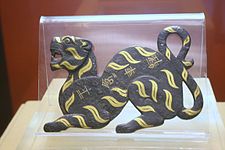- Fu (tally)
-
For other uses, see Fu.
In ancient China a fu (Chinese: 符) was a tally, made of bamboo, wood, metal (gold, silver, bronze) or jade and used as a proof of authorization.[1] Most commonly, fu were made of wood or bamboo in sizes of wooden slips or bamboo chopsticks.[1] Although fu have been made in various shapes (such as tiger, dragon, turtle, snake, fish or human), most of them come in the shape of a tiger.[1]
Hu-fu
See also: Tiger in Chinese cultureThe two-piece tiger tallies (hu-fu, 虎符 in Chinese) were used by an emperor to command and dispatch the army. The right piece was retained in the central government while the left piece was issued to the local officials or commanders. If someone wanted to dispatch the troops from a certain area, he had to show the right piece of the tiger tally in order to obtain authorization; both pieces of the tally had to match each other.[2] The word hu-fu first appears in the biography of Hsin-ling in the Records of the Grand Historian, which tells the story of the stealing of a tiger tally to relieve the state of Zhao.[3] During the Warring States period this kind of fu was changed from jade to bronze.[3]
References
- ^ a b c "Tally(符 Fu)". China Info Online. http://www.chinainfoonline.com/Ancient_Relics/Tally.htm. Retrieved 28 Sept 2011.
- ^ "Tiger Tally". China Ancient. http://www.chinancient.com/tiger-tally/. Retrieved 28 Sept 2011.
- ^ a b Needham, Joseph (1981). Science in traditional China: a comparative perspective. Chinese University Press. p. 97. ISBN 9622012124.
Categories:- Traditional Chinese objects
- History of Ancient China
- Chinese words and phrases
Wikimedia Foundation. 2010.

